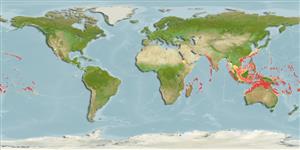Common names from other countries
>
Holocentriformes (Squirrelfishes, soldierfishes) >
Holocentridae (Squirrelfishes, soldierfishes) > Holocentrinae
Etymology: Sargocentron: Greek, sargos = sargus + Greek, kentron = sting (Ref. 45335).
More on author: Günther.
Environment: milieu / climate zone / depth range / distribution range
Ecologia
marinhas associadas(os) a recifes; intervalo de profundidade 0 - 183 m (Ref. 1602), usually 1 - 35 m (Ref. 58302). Tropical; 35°N - 25°S
Indo-Pacific: Chagos Archipelago, Astove in Seychelles, and Maldives to the Hawaiian, Line, and Tuamoto Islands, north to the Ryukyu and Bonin Islands, south to Austral Islands; throughout Micronesia.
Tamanho / Peso / Idade
Maturity: Lm ? range ? - ? cm
Max length : 20.0 cm TL macho/indeterminado; (Ref. 4201)
Espinhos dorsais (total): 11; Raios dorsais moles (total): 12-14; Espinhos anais 4; Raios anais moles: 9 - 10. Body with red and white stripes of different widths; head reddish above, silvery below; faint red band from eye to angle of preopercle; spinous dorsal white, with a submarginal zone of red (Ref. 4201). Five oblique scale rows on cheek; body moderately elongated, depth 2.9-3.5 in SL; head length (HL) 2.8-3.4 in SL; snout length 3.9-4.35 in HL; interorbital width 4.15-4.5 in HL; maxillary reaching to about below front of iris, upper jaw length 2.85-3.15 in HL; premaxillary groove reaching to about a vertical at the front edge of orbit; anterior end of nasal bone rounded; 1-2 spinules at medial margin of nasal bone; small nasal fossa without spinules on its edge (except a 16.3 cm specimen from the Society Islands with 1 spinule); upper edge of suborbital bone weakly serrated, spineless laterally; short preopercular spine 1/4-1/3 orbit diameter, 6.15-7.95 in HL; 3rd-5th dorsal spine longest 1.5-1.95 in HL; extremely long 3rd anal spine 1.0-1.2 in HL (Ref. 27370).
Inhabits virtually all coral reef zones (Ref. 1602). Benthopelagic in or near crevices and holes (Ref. 58302). Common in thickets of staghorn Acropora or in large Pocillopora heads (Ref. 1602). Feeds on small crustaceans, worms, and fishes during the night (Ref. 30874). Spine of preopercle venomous. Minimum depth reported taken from Ref. 128797.
Life cycle and mating behavior
Maturidade | Reprodução | Desova | Ovos | Fecundidade | Larvas
Randall, J.E., 1998. Revision of the Indo-Pacific squirrelfishes (Beryciformes: Holocentridae: Holocentrinae) of the genus Sargocentron, with descriptions of four new species. Indo-Pac. Fish. (27):105 p. (Ref. 27370)
Categoria na Lista Vermelha da IUCN (Ref. 130435)
CITES (Ref. 128078)
Not Evaluated
Utilização humana
Aquário: Aquários públicos
Mais informação
ReferênciasAquaculturaPerfil para aquaculturaEstirpesGenéticaElectrophoresesHereditariedadeDoençasProcessamentoMass conversion
Ferramentas
Relatórios especiais
Descarregue XML
Fontes da internet
Estimates based on models
Preferred temperature (Ref.
115969): 24.9 - 29, mean 27.8 (based on 1198 cells).
Phylogenetic diversity index (Ref.
82804): PD
50 = 0.5000 [Uniqueness, from 0.5 = low to 2.0 = high].
Bayesian length-weight: a=0.01585 (0.00935 - 0.02687), b=3.13 (2.99 - 3.27), in cm Total Length, based on LWR estimates for this species & Genus-body shape (Ref.
93245).
Nível Trófico (Ref.
69278): 3.6 ±0.58 se; based on food items.
Resiliência (Ref.
120179): Elevada, tempo mínimo de duplicação da população menor que 15 meses (K=1.00).
Fishing Vulnerability (Ref.
59153): Low vulnerability (14 of 100).
